stocking
Genetic Monitoring of Bloater Broodstock using a GTSeq (Genotypes by thousands sequencing) Panel
Hatchery production is a central component of coregonine restoration within the Great Lakes ecosystem, and active supplementation programs are currently underway in Lakes Ontario and Huron. As the development of coregonine broodstock lines and methods associated with...
Hatchery production and research to support restoration of sutainable Coregonine populations in Lake Ontario and Lake Erie – Year 7
Coregonine species in the Great Lakes, such as Cisco and Bloaters, historically represented a substantial component of the forage base for native cold-water fish like Lake Trout and Atlantic Salmon. Extirpation or depletion of deepwater Bloater populations has left...
Continuing evaluation components of the Lake Huron Technical Committee’s Cisco reintroduction study for FY25
Cisco (Coregonus artedi) are functionally absent from the western main basin of Lake Huron and as such restoring Cisco “to a significant level” (DesJardine, 1995) remains an unmet objective for Lake Huron management agencies (Riley and Ebener, 2020). In 2007 the Lake...
Evaluation of sequential chemical marking of Oxytetracycline, Alizarin Red S, and Calcein in calcified structures of bloaters (Coregonus hoyi)
This project will investigate the unique chemical marking patterns produced within the otoliths, lower jaw, and ribs of bloaters after sequential immersions of Oxytetracycline (OTC), Alizarin Red S (ARS), and calcein. This project is fully aligned with the Coregonine...
Evaluating post-stocking movement, mortality, and habitat use of fall-stocked cisco Coregonus artedi in Saginaw Bay, Lake Huron with acoustic telemetry
The Lake Huron Committee aims to restore cisco Coregonus artedi in Lake Huron (DesJardine et al. 1995; Lake Huron Technical Committee 2023). To that end, the Lake Huron Technical Committee has implemented a plan for re-establishing a population in the main basin of...
Is handling and transport stress limiting post-stocking survival of yearling bloater C. hoyi in Lake Ontario?
Bloater (C. hoyi) have been stocked in Lake Ontario for 11 years with limited success (15 total recaptures; Weidel et al., 2022). Short term (1-12 days) post-stocking survival has been estimated at 42% with 22% of the mortality occurring in the first hour post-release...
Developing a high throughput method to genotype coregonines at a standardized panel of loci for genetic monitoring and parentage-based tagging applications
A central component of coregonine restoration in the Great Lakes is hatchery production, and active supplementation programs are underway in Lakes Ontario and Huron. Importantly, these efforts must consider the decades of work in other salmonids that demonstrate...
Supporting evaluation components of the Lake Huron Technical Committee’s Cisco reintroduction study for FY24
Cisco (Coregonus artedi) are functionally absent from the western main basin of Lake Huron and as such restoring Cisco “to a significant level” (DesJardine 1995) remains an unmet objective for Lake Huron management agencies (Riley and Ebener 2020). In 2007 the Lake...
Can stocked Bloater (Coregonus hoyi) survival be increased with environmental conditioning?
Bloater (Coregonus hoyi) were historically an important component of the Lake Ontario fish community but the species was likely extirpated by the 1970’s. A binational restoration has stocked over one million Bloater into Lake Ontario since 2012, however, low...
Supporting evaluation components of the Lake Huron Technical Committee’s Cisco reintroduction study for FY23
Cisco (Coregonus artedi) are functionally absent from the western main basin of Lake Huron and as such restoring cisco “to a significant level” (DesJardine 1995) remains an unmet objective for Lake Huron management agencies (Liskauskas et al. 2007). In 2007 the Lake...
Supporting evaluation components of the Lake Huron Technical Committee’s Cisco reintroduction study: a multi-agency effort to promote Cisco recovery in the western main basin of Lake Huron (FY22)
The U.S. Fish and Wildlife service conducted larval coregonine surveys in 2022 aimed at documenting the current distribution, composition, and density of the larval coregonid community in Saginaw Bay. Sampling of the ichthyoplankton community was limited to pelagic...
Region 3 wild coregonine brood stock collection activities for FY 2021 in support of restoration activities on Lake Huron and Lake Ontario
The U.S. Fish and Wildlife Services Midwest Region Fisheries Program carried out two projects in support of a multi-agency effort to restore coregonid populations in Lakes Huron and Ontario. The first project began in 2015 when USFWS began documenting the spawning...
A coordinated approach to monitoring of a coregonine brood and cultured progeny in the R3 FWS hatchery program
Broodstock management and monitoring programs are vital components of all types of stocking initiatives (e.g. Captive, Supportive, restorative, rescue). Broodstock collection and development should aim to preserve genetic diversity and minimize inbreeding and stocking...
Supporting evaluation components of Lake Huron Technical Committee’s cisco reintroduction study: a multi-agency effort to promote cisco recovery in the western main basin of Lake Huron (FY21)
The U.S. Fish and Wildlife service conducted larval coregonine surveys in 2021 aimed at documenting the current distribution, composition, and density of the larval coregonid community in Saginaw Bay. Sampling of the ichthyoplankton community was limited to pelagic...
Supporting evaluation components of the Lake Huron Technical Committee’s cisco reintroduction study: a multi-agency effort to promote cisco recovery in the western basin of Lake Huron (FY19)
The U.S. Fish and Wildlife service conducted two surveys in 2019 aimed at documenting the current distribution, composition, and density of the larval coregonid community in Saginaw Bay. Sampling was limited to pelagic ichthyoplankton and beach seining due to the...
How many cisco should be stocked, and at what life stage?
Historically, members of the coregonine complex (Coregonus spp.) were the most abundant and ecologically important fish species in the Great Lakes (especially the cisco C. artedi), but anthropogenic influences caused nearly all populations to collapse by the 1970s....
Developing a Great Lakes-wide database of coregonine stocking
A database of information associated with the release of hatchery-raised Coregonine fishes of Great Lakes origin was constructed and populated with all available records (>4,700) of stocking events. The information includes species, quantities, life stages, source...
